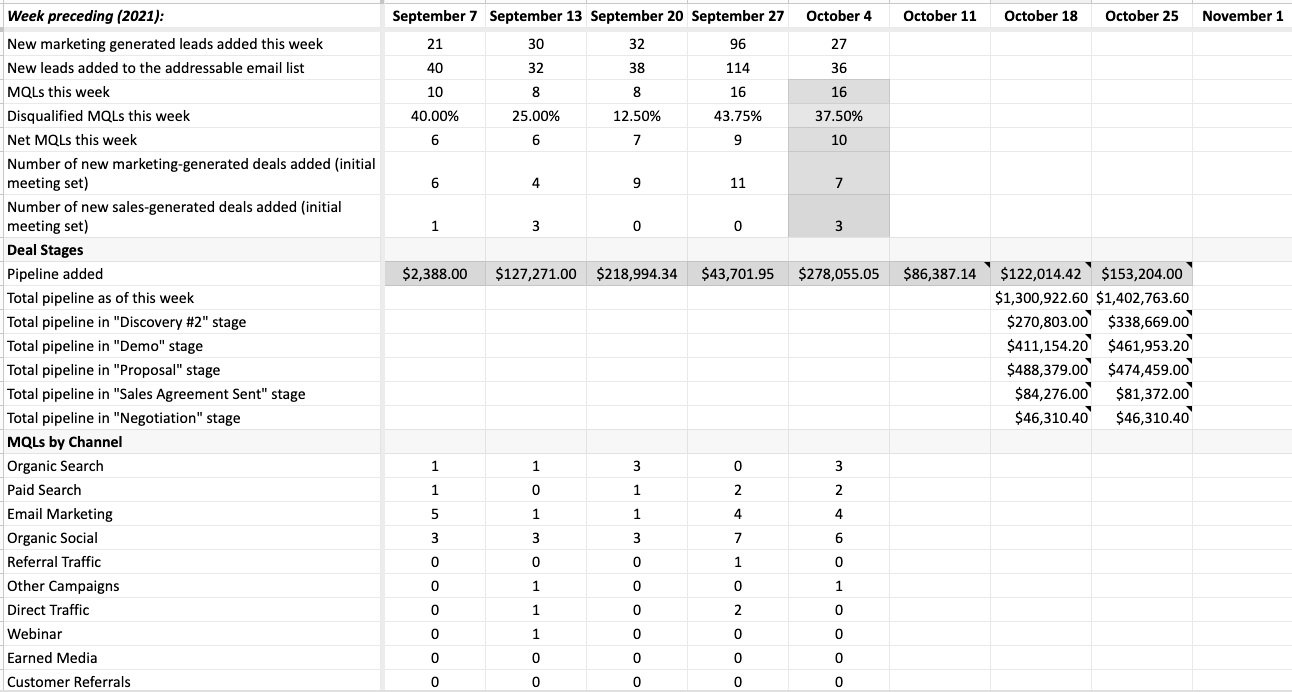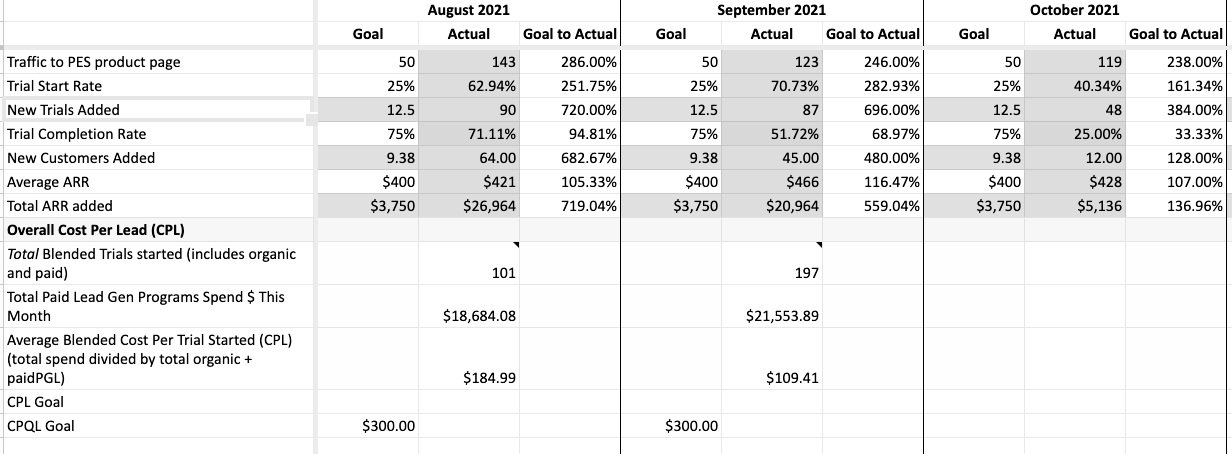Creating a Go-To-Market Operating System
One thing that all high-performing go-to-market (GTM) teams have in common is an operating system that helps drive alignment, transparency, and focus on goal attainment.
A well-run GTM operating system creates clarity about what’s important to the business and the levers that impact growth.
When I start working with a company, one of the first things we usually do together is implement a GTM operating system based on three pillars:
A metrics framework to review essential GTM data. This includes leading indicators and goal-to-actual results for all key growth levers.
A cadence for reviewing the metrics framework, designed for inspection, assessment, and action.
A culture of alignment, transparency, purpose, and focus.
Go-to-market strategy and initiatives are what drives growth, but in my experience, it’s the operating system that enables it. Without it, there is no rudder to keep everyone on track, rowing in the same direction.
The outcomes of reviewing the right metrics, at the right intervals, with the right people in the room can change a company’s growth trajectory.
The GTM Metrics Framework
“In general, a framework is a real or conceptual structure intended to serve as a support or guide for the building of something that expands the structure into something useful.” -TechTarget
The foundation of any GTM operating system is the framework for tracking metrics and growth levers. The data included in the GTM framework is unique to each company but should consist of leading indicators and a way of quickly assessing goal-against-actual outcomes.
The layout of the metrics is important, and it needs to be structured so that it’s easy to understand performance so that the right adjustments can be made to impact performance moving forward.
The framework I favor is just a single document that includes all critical GTM data. Spoiler alert…the format itself isn’t anything fancy or complex. It’s just one big spreadsheet with lots of tabs.
When I ask teams to use a single sheet as their GTM framework, it’s sometimes a hotly debated topic because all the data collected into the sheet already lives in other systems. There can be some internal resistance to bringing data into a single file from many disparate sources.
Of course, the single file does not replace the dashboards and systems where the data resides. In fact, if I look at the GTM framework once a week, I’m probably in the real-time dashboards ten times a week.
The framework is critical because it brings the most important GTM data into a unified, connected view set up in a specific way that makes it simple to understand the GTM growth levers and how the business is performing against targets. In my experience, you can’t get this from automated mega reports or dashboards. The metrics you need in your framework are too specific, and in some cases even sourced from a person (like the sales forecast).
With the right framework, we can see where we are doing well and where we aren’t and make quick decisions to improve. It makes data inspection, assessment and action so much easier.
Without the framework, every time you sit down to look at GTM performance, you need several files pulled up, a bunch of tabs open in your browser, and a lot of aspirin. The review usually goes off the rails when someone’s looking at Salesforce, where it says we got 100 MQLs last month from LinkedIn. Someone else is looking in Marketo where it says something different, and someone else is looking in the LinkedIn file and sees there were only 25. It always goes like this. Always.
When everything isn’t in a single view, there is no clarity and no consistency. There can’t be team-wide visibility into the metrics that drive growth when you have to go pull up data that lives in many different places in varying formats. And yes, dashboards do solve for this….to a point. But part of an effective review of data is the format you are using. For me, that format needs to be a single view into all the key metrics in one place, how we’re pacing against goals right now, and how we’re faring week over week.
That’s why I always recommend starting with a metrics framework that’s created in one sheet. Use the format for a few months until you are certain it has the right data and layout, and then if you want to set up an alternative approach that automatically pulls in the data from all the data sources, go for it.
It’s Not Just About Reviewing Data, it’s About Predicting Growth
The point of the GTM metrics framework isn’t to look at data, it’s actually to look at how the GTM organization is pacing to hit goals. For most companies, one of the main components of the framework is a bottom’s up model that takes into considerations all the primary growth levers. By plugging in baseline metrics we can model what that will yield over the course of a period of time, such as the upcoming year. We can then make adjustments to the levers in the model to anticipate potential outcomes.
With the model, we can see what happens if we increase our MQLs by 2% a month every month. Or what happens if our average contract value increases by $2,000. Or what happens if we increase our website traffic .5% every month. Anything that is a lever or input can be adjusted in order to see the impact.
From this vantage point, achievable goals can be set and tracked throughout the year and growth can become more predictable.
That’s the real magic of the framework. Knowing what the growth levers are and tracking performance on those levers throughout the week, month, quarter and year.



By the way, if you are curious about what’s included in a GTM metrics framework and are an Arthur Ventures partner company, we can send you some examples & templates as a starting point.
The GTM Operating System Cadence & Culture
The cadence of reviewing your GTM metrics framework is just as important as the framework itself.
Nothing about a go-to-market is “set it and forget it”. The very purpose of the framework is to enable frequent evaluation of the data to take action and impact the outcomes.
The following cadence works well in sales-driven, product-led, transactional, and enterprise motions. In other words, I’ve yet to see a B2B situation where the cadence needs to be adjusted. I imagine a very high-volume B2C business might want to do a brief daily review as well. But for B2B, this is the cadence that works.
The Weekly Review
A subset of data in the GTM framework should be reviewed weekly—typically the highest level results (like new bookings) and a set of leading indicators that give a glimpse into probable future outcomes (like new MQLs). Reviewing the leading indicators helps you see how things are pacing, and what might need to be adjusted.
Think of this step as evaluating the symptoms (both good and bad), so you can then diagnose & treat the problem. This might include changing something that’s not delivering results or doing more of something that’s working better than expected.
The people that participate in the weekly review depend on the stage and size of your company, and anyone responsible for the GTM programs should be included. At an early-stage company that might consist of the founders and a couple of individual contributors, at a later-stage company, it will probably include the sales, marketing, and ops leaders along with a few key members of each team.
The weekly review is a 30-minute meeting. The report should be reviewed in advance so that the meeting can focus on discussion.
The Monthly Review
The monthly review is an opportunity to step back and look at overall performance holistically. Because of the weekly review, there should be few surprises in the monthly review. Instead, it’s a time to discuss what’s working and what isn’t and how the GTM organization is performing compared to the plan.
The outcome of the monthly review should be a set of action items—new initiatives to implement, what needs to be modified, and what needs to be paused entirely.
The same team members who attend the weekly meetings attend the monthly. In addition, you might want to bring in the entire marketing team and company leadership (depending on how your teams are structured).
The monthly review is a 60-90 minute meeting. The report should be reviewed in advance so that the meeting can focus on discussion.
Quarterly Planning
I favor agile marketing run in two or three-week sprints for managing the tasks and projects, but quarterly GTM planning is important in order to reflect on the outcomes of the prior three months and to determine the cross-functional goals and initiatives for the coming three months.
It’s time-intensive. And worth it.
The most common question I get from leadership teams is, “Who will set this up, and how much time is this going to take to run this on an ongoing basis?
I’ll give you a rule of thumb, but first, I will say my overall perspective on this question is, ”What could be more important than setting up the proper framework and cadence for reviewing your go-to-market growth levers?”
Ideally, there is a sales and marketing operations manager who can own the framework itself. If not, then the most data-minded person on the team should take the helm.
To give you a realistic idea of how much time this takes, I asked someone in the portfolio who runs their GTM operating system like a well-oiled machine. He’s a sales & marketing operations manager and was responsible for setting up his company’s initial framework. He also updates the data each week and month and provides analysis & insights as he leads the team through the review meetings.
1 hour per week to pull the data & analyze it for insights (total 4 hours per month)
30 minutes to attend the weekly meeting (2 total hours per month)
2 hours to pull the data for the monthly report
1 hour to attend the monthly meeting
By the clock, that’s a total time of 9 hours per month for the person preparing the data & analysis for the meetings. On top of that, you have the time investment of everyone who attends the meetings.
The GTM culture
If culture eats strategy, then most certainly the go-to-market operating system eats strategy too. The best plan in the world will fall flat if there aren’t targets, measurements, assessments, and refinements.
So often when I ask go-to-market teams about their goals, they don’t have any. Or they have goals that are tied to activities like writing blog posts.
Activities are great, but activities should be done in service of achieving a business goal. When someone’s work isn’t tied to the big picture of the desired outcomes, it’s less meaningful (and usually less effective).
Writing blog posts in order to help achieve a goal of increasing organic traffic 10% this quarter is far better for a teammember than just a goal of ‘write 10 blogs posts’. Activities aligned to larger goals provide purpose and meaning to our work.
The GTM operating system connects our work to goals. It signals to everyone what is important by putting specific metrics front and center on a regular basis in a methodical way. It reminds us of why we’re doing what we’re doing. It provides clarity about what levers will drive growth, what the goals are, and if we’re on track.
This is the foundation of a high-performing team. For me, it starts with an operating system designed to get everyone working together towards common goals, in alignment with the big picture of what we’re trying to achieve.
